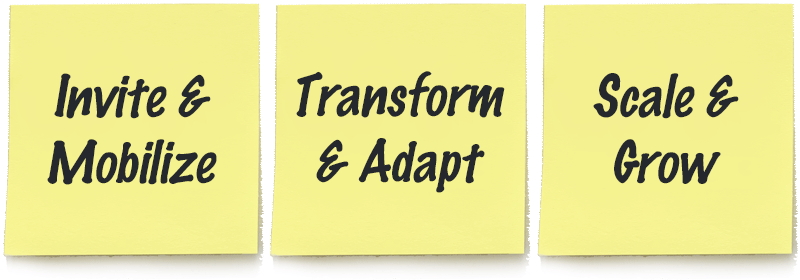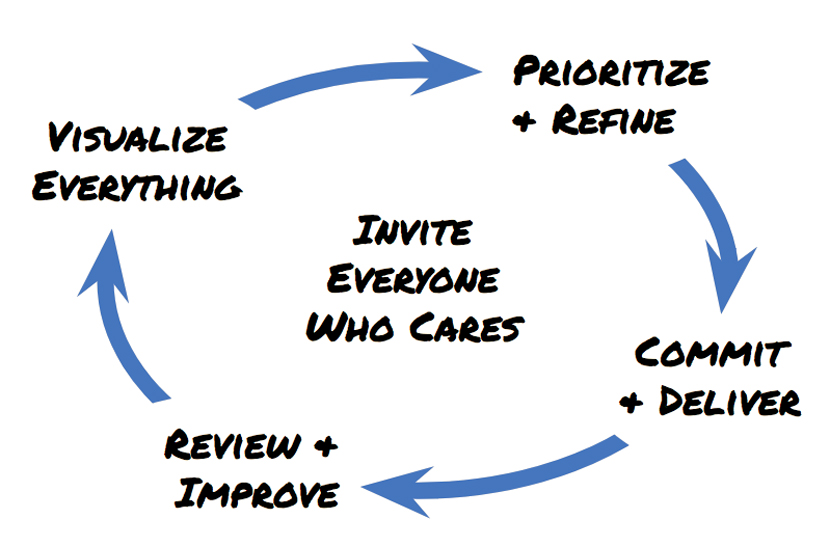All Hands. All Issues. All Together.
Eighteen months after the Agile Manifesto was first published in 2001, I introduced the Agile software development community to Open Space Technology. They’d asked me to facilitate one track (The Future of Software) at their first global conference. When they explained “Agile,” “Scrum,” and “Kanban” to me, I laughed out loud, “You’re making software in Open Space!” They agreed, but also conceded that the didn’t really know how to do a conference that way.

Most people think of Open Space as a way to have extraordinary, self-organizing meetings, with any number of people and issues. Kanban comes from Japanese manufacturing and Scrum was created for software development. These two are the most widely practiced Agile methods. But when we look at what’s really happening in Open Space, Kanban, Scrum, and other Agile methods, the game is essentially the same: We put everything that matters on the wall. And then we get it done.
Since that first conference, the Agile movement has blossomed (or soured, some say) into a global industry powered by certification training and rich corporate coaching budgets. At the same time, Open Space has spread even more widely, applied in every kind of organization, all around world, mostly powered by sharing and experimentation.
So why connect the two? Because Open Space is especially good at getting (inviting) everyone who matters into the room (all hands, all stakeholders) – and getting all the issues and ideas that matter up on the wall. Then Agile marshals the management rigor to learn, adapt, implement and deliver. Both are complete in themselves, but I think they’re even stronger together.
Inviting Agility is a mindset anyone can learn – and methods any leader, team and organization can adopt. Inviting Agility enables us to adapt quickly and effectively to all forms of change and disruption. In these crazy, turbulent times, this is the only way to deliver maximum value and greatest satisfaction – for customers, employees and everyone else impacted by our work.
First, Inviting recognizes that people are powerful and can be ideal-seeking. So Inviting organizations empower people by not disempowering them in the first place. Inviting Leaders use invitations to bring people together, focus effort, and address the most complex, conflicted and urgent issues. Inviting engages and aligns the full power of any group and makes the strongest vision and alignment.
Then, Agility is about managing in complexity, uncertainty, ambiguity and change. Agile teams and organizations maximize value, accelerate learning, manage risk and eliminate waste by working in small increments. They visualize everything, set priorities and refine shared understanding. They commit and deliver, review and improve, learn and adapt in short, steady cycles. Agile is a rigorous, but sustainable, way to collaborate and supports the most productive workflows.
Together, Inviting Agility gives leaders and champions, at any level of an organization (or community), the ability to engage and align any number of people (5 to 5000), to address any important issue, purpose, challenge or question, AND the management rigor needed to implement solutions and lead effective transformation.
Simple. Powerful. Possible.
The people engaged might be co-workers, in start-ups or silos, or customers, stakeholders, community members, parishioners, or students. Or likely a bit of a mix. But always with some important, shared purpose. That might be a new or improved product, the future of the business, or the future of something even larger, like eduction, affordable housing, race relations or peace. These tools work everywhere you do.
Inviting Agility is the new way of working. It changes everything – in immediately accessible and powerfully effective ways. In practical terms, it’s the adaptation of the simple, powerful, time-tested patterns embodied in four foundational practices:
- Open Space – to get people and workgroups moving together
- Kanban – to visualize and support the flow of work and results
- Scrum – to accelerate learning and delivery incrementally
- Enterprise Scrum – to scale Scrum and Agilize anything
Open Space has invited responsible self-organization in any size group, with complex and urgent issues, in every kind of organization, around the world, for several decades. The other three are Agile methods. Kanban originated in manufacturing, but it’s been widely adopted in Agile software development to visualize and manage the flow of work. Scrum is the single most widely used framework for Agile product development and project management. Its concise 16-page Guide defines a small handful of roles, artifacts, and ceremonies that accelerate learning and delivery and can be useful in any kind of work. Finally, Enterprise Scrum generalizes and scales Scrum, to agilize and transform any organization or institution, toward true, enterprise-wide agility.
Each of these approaches, in its own way, harnesses the simple, durable power of people and relationships, passion bounded by responsibility, big visions and immediate next steps, and the inescapable need to learn, adapt and evolve. These are the foundations of Inviting Agility. These practices make all kinds of extraordinary results possible.

Meetings. Teams. Enterprise.
The materials in the Resources pages will help you learn your way into them. There’s no required starting point or “readiness” criteria. Start wherever you want or need to be more effective:
- make all-hands meetings super productive (on major issues, with senior leadership, and/or with dozens to hundreds of participants)
- support individual teams and outcomes improvement (including the C-suite), and/or
- manage the strategic future/transformation of the entire enterprise.
At each of these levels, the four foundational practices all drive the same essential learning cycle. They’re not magic, but they will generate extreme clarity, surprisingly quickly – about customers, value, workflow and obstacles. This enables the real magic, the people who do the work, to deal with all of them directly and effectively.

